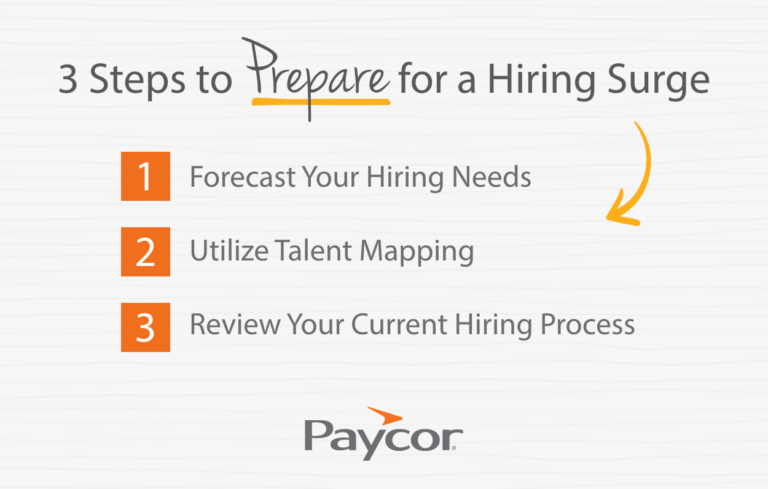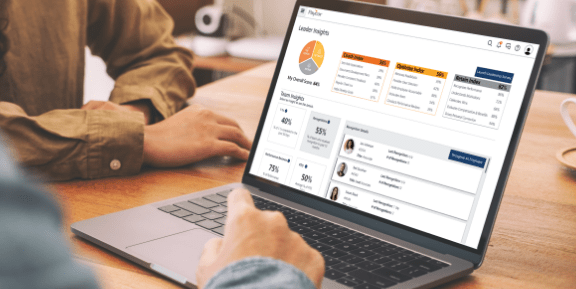During a hiring surge, recruiters and HR professionals face intense pressure to fill a number of roles in a short amount of time. And because hiring surges are cyclical — often occurring at the start of a new year and between Q3 and Q4 — companies compete for the top talent and must move quickly.
Preparation for a hiring surge requires refining the recruitment and hiring process to ensure efficiency and effectiveness in selecting the best candidate for each opening.
What is a Hiring Surge?
A hiring surge occurs when a business must rapidly increases its workforce to meet heightened demand. This can be driven by seasonal fluctuations, such as the holiday shopping rush for retailers, or by sustained business growth, like a company launching new products or expanding into new markets.
Hiring surges are common at the start of the new year when departments have renewed budgets and strategic initiatives, and in September through October, when department leaders want to use any remaining budget before the fiscal year ends to hire quality workers before the holidays.
Hiring Surge Preparation

Prepare for a hiring surge with the following steps.
Forecast Your Hiring Needs
Accurate labor forecasting clues you in to when the next hiring surge may happen and ensures you’re prepared to fill the most in-demand roles. Analyzing historical data enables businesses to identify patterns in demand that may signal the need for additional staff, such as seasonal peaks or market expansion.
Understanding market trends is equally important, as it helps predict shifts in workforce availability and industry-specific labor needs. These insights enable companies to plan ahead, avoiding understaffing during critical periods or overstaffing during lulls.
Utilize Talent Mapping
Talent mapping helps with forecasting hiring needs by analyzing the skills, roles, and growth potential within the current workforce. It allows businesses to identify gaps in talent, plan for succession, and align workforce capabilities with long-term objectives.
After talent mapping, revisit job descriptions to ensure you’re looking for candidates who fill specific skills gaps. This proactive approach ensures businesses are prepared to meet immediate hiring demands and equipped to support strategic growth.
Review Your Current Hiring Process
Recruiters and hiring managers must act fast during a hiring surge, so it’s critical to review your current hiring processes to identify any bottlenecks or inefficiencies. Conducting this evaluation before the hiring surge leaves time for improving the hiring process.
How to Improve the Hiring Process
Once you review your current hiring process, start implementing changes that address inefficiencies, such as the following.
Streamline Candidate Review with Applicant Tracking Software
During high volume periods, an applicant tracking system can help streamline candidate review and move the process along. For example, Paycor recruiting software includes a candidate dashboard that shows job candidates, recruiting status, and high-priority job listings in one place. Its interview scorecards empower you to evaluate candidates, track their performance through the hiring process, and compare their qualifications to find the right fit for each open role.
Test Candidate Quality With Pre-Employment Assessments
Consider a pre-employment assessment to gauge whether a candidate has the right knowledge, skills, and attributes for the open positions. These assessments, which can include skills tests, personality evaluations, or situational judgment exercises, provide valuable insights into a candidate’s potential performance and cultural fit.
By automating this step, businesses can efficiently narrow down the applicant pool, eliminating job seekers who do not meet the role’s requirements. This allows hiring teams to focus their time and resources on top-quality candidates, speeding up the recruitment process while improving hiring accuracy.
Maintain Clear Communication with Candidates
Provide candidates with timely and transparent updates to keep them engaged throughout the hiring process. Regularly sharing information about application status, interview timelines, and next steps helps reduce uncertainty and demonstrates professionalism. And if a candidate is interviewing for multiple companies, these updates show you care and may give you a competitive edge.
Recruitment software often includes tools to simplify and expedite candidate communication. For example, Paycor offers candidate texting, allowing hiring managers to stay connected, send timely updates, and build strong relationships with candidates.
How to Improve the Recruitment Process
During a hiring surge, companies may be vying for the same candidates, meaning recruiters need to be on top of their game. Learn how to improve the recruitment process below.
Train and Support Your Recruitment Team
Recruiters often face high levels of stress during hiring surges, as they manage increased workloads while competing for top candidates. To support them, empower your team with tools that automatically curate a prioritized list of candidates for every role, like Paycor Smart Sourcing. Prioritize training on AI recruiting software to ensure recruiters understand how to use the tools for their gain.
Monitor Recruitment Metrics
Tracking recruitment metrics is essential to staying agile during hiring surges. Focus on key performance indicators, such as time-to-fill, cost-per-hire, and candidate conversion rates to gauge process efficiency. Regularly reviewing these insights allows you to identify bottlenecks and adjust strategies as needed. For instance, if the time-to-fill is consistently long, consider expanding sourcing efforts or streamlining interviews to maintain momentum in hiring.
How Paycor Helps
Paycor recruiting software and automated talent sourcing empower HR professionals with the tools they need to function at their highest level, so they’re prepared for the day-to-day and the next hiring surge. From AI-powered campaigns that proactively reach out to candidates to custom start-to-finish hiring workflows, Paycor offers everything you need to handle hiring.
But the support doesn’t stop there. The platform includes tools for onboarding, benefits management, payroll, and more. Check out a demo to see the software in action.









